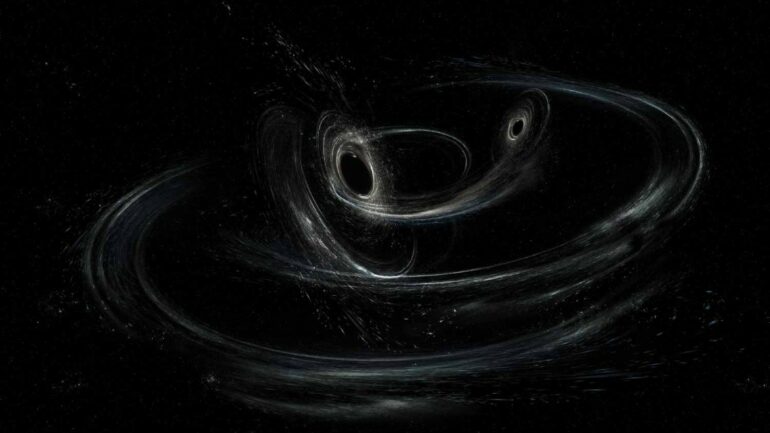Research done at Cornell University has uncovered from gravitation wave data the first potential signs of spin-orbit resonances in binary black holes, a step toward understanding the mechanisms of supernovas and other big questions in astrophysics.
“These resonances were predicted over a decade ago using Einstein’s theory of general relativity,” said astrophysicist Vijay Varma. A former Klarman Postdoctoral Fellow in the College of Arts & Sciences (A&S), Varma analyzes gravitational waves detected by the Laser Interferometer Gravitational-Wave Observatory (LIGO) and the Virgo gravitational wave detector in order to learn more about binary black holes. “We find the first ‘hints’ of the resonances in gravitational wave data from LIGO and Virgo.”
The rate at which a black hole spins reveals a lot about its history, Varma said: For black holes arranged in an interactive pair, called a binary, the direction of each black hole’s spin is also revelatory, especially in relation to one another.
In “Hints of Spin-Orbit Resonances in the Binary Black Hole Population,” published January 19 in Physical Review Letters, Varma and collaborators report that the two black holes’ spins, when projected onto the orbital plane, tend to be anti-parallel to each other, which can be a signature of spin-orbit resonances. More observations are needed to confirm these tendencies, Varma said.
Varma conducted much of this research while a Klarman Fellow; he is now a Marie Curie fellow at the Max Planck Institute for Gravitational Physics. Collaborators on this work include Syliva Biscoveanu, Maximiliano Isi and Salvatore Vitale from the Massachusetts Institute of Technology, and Will Farr from the Flatiron Institute.
“Resonance effects are ubiquitous in physical systems. They occur when two processes in a system occur at specially related frequencies,” said Saul Teukolsky, the Hans A. Bethe Professor of Physics (A&S), Varma’s faculty mentor at Cornell. “In the black hole systems that Vijay is studying, the resonance is predicted to occur between the spin motion of the black holes and their orbital motion, and leaves an imprint on the gravitational waves produced. This work shows that if we analyze the data cleverly, we are much closer to testing this prediction of General Relativity than we thought we were.”
Black holes typically rotate (spin) because they form from dying stars that spin themselves, Varma said. When two such black holes orbit each other in a binary, their spins interact with the orbit.
Binary black holes lose energy to gravitational waves, causing the black holes to move toward each other and eventually merge, Varma said. Some binary black hole spins are aligned along or opposite the orbital angular momentum, leading to a “bland” merger on a fixed plane. But other binary black holes have spins tilted with respect to the orbital angular momentum, setting off an intricate interaction called precession.
“When the spins are tilted with respect to the orbital angular momentum, the orbit precesses like a top that is spinning along a tilted axis,” Varma said.
Spin-orbit resonances can occur in precessing binaries, but this depends on the nature of the supernova mechanism that produces the black holes from their stellar progenitors, Varma said. If the supernova emission is not symmetric in all directions, the black hole gets a recoil velocity at birth, which is similar to the recoil of a fired gun.
“If the supernova recoils are large enough, the binary can end up in a spin-orbit resonance,” Varma said. “These are special configurations where the spins directions in the orbital plane are either parallel or anti-parallel.”
It was thought that LIGO and Virgo gravitational wave detectors were not sensitive enough to pick up evidence of spin-orbit resonances. However, Varma and collaborators applied two data-gathering hacks in order to detect these first hints.
First, Varma applied computer modeling based on simulations of black holes.
“Vijay is a world expert at developing what are called ‘surrogate models,'” Teukolsky said in a 2020 interview.
Varma said, “These models accurately capture the effect of the spins from numerical simulations. They allow us to extract as much of this information as possible from gravitational wave observations.”
Second, the researchers learned to measure the spins just before the black holes merge, rather than the standard practice of measuring spins many orbits before the merger. This method of late spin measurement is the topic of a companion paper, “Measuring binary black hole orbital-plane spin orientation,” published January 19 in Physical Review D.
“We are starting to probe the spin-orbit resonances, which we originally thought was impossible until next-generation detectors arrive in the 2030s,” Varma said. “Our hope is that by studying these spin-orbit resonances, we can learn more about the mechanism of the supernova, which has remained an enduring mystery.”
More information:
Vijay Varma et al, Hints of Spin-Orbit Resonances in the Binary Black Hole Population, Physical Review Letters (2022). DOI: 10.1103/PhysRevLett.128.031101
Vijay Varma et al, Measuring binary black hole orbital-plane spin orientations, Physical Review D (2022). DOI: 10.1103/PhysRevD.105.024045
Provided by
Cornell University
Citation:
Binary black hole spin behavior revealed using novel techniques (2022, January 26)



